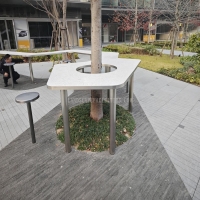Welcome to the website for landscape facilities products and knowledge.
What are the cost implications of adding heating or cooling elements to a landscape bar counter?
The integration of heating or cooling elements into a landscape bar counter transforms it from a seasonal luxury into a year-round entertainment hub. However, this upgrade carries significant financial considerations that extend far beyond the initial purchase price of the units. A thorough cost analysis is essential for any homeowner or business owner contemplating this enhancement to their outdoor living space.
The most immediate cost is the procurement of the climate control systems themselves. For heating, options range from electric infrared heaters, which provide directed warmth and are highly efficient, to more traditional propane patio heaters. Cooling solutions are less common but can include integrated misting systems or even specially designed outdoor-rated evaporative coolers. The price spectrum here is vast; a basic electric heater can start at a few hundred dollars, while a high-end, custom-integrated misting or cooling system can climb into the thousands.
Installation expenses form a substantial, and often underestimated, part of the budget. This is not a simple DIY project. It typically requires the expertise of licensed electricians and possibly plumbers. Running dedicated electrical lines from the main power source to the bar location involves conduit, wiring, and potentially trenching, which dramatically increases labor and material costs. For gas-powered heaters, a certified professional must install a gas line, ensuring it meets all safety codes. The complexity of the installation is directly tied to the bar's distance from the home’s utilities and the local permitting requirements, which add both time and money to the project.
Beyond the upfront investment, the operational costs, or ongoing energy consumption, are a critical long-term factor. Electric heaters, particularly infrared models, are efficient in their heat transfer but can significantly increase electricity bills during colder months. Propane heaters require a constant supply of fuel tanks, an ongoing expense that must be factored in. Similarly, misting systems use both water and electricity to run their pumps, contributing to monthly utility bills. The cumulative effect of these operational costs can be considerable over a year.
Finally, one must consider maintenance and potential future repairs. Outdoor elements are harsh. Heating elements and cooling nozzles are exposed to rain, sun, and temperature fluctuations, which can lead to corrosion, mineral buildup (in misting systems), and general wear. Annual servicing, part replacements, and the eventual need for a full system upgrade years down the line are all part of the total cost of ownership.
In conclusion, while adding climate control to a landscape bar counter undeniably elevates its functionality and comfort, the financial implications are multifaceted. A realistic budget must account for the equipment, complex professional installation, a rise in monthly energy consumption, and a commitment to ongoing maintenance. Weighing these costs against the intended use and desired ambience of the outdoor space is crucial for making an informed and sustainable investment.
Related search:

Recommendation
An outdoor bar counter with stainless steel and terrazzo materials in an irregular shape